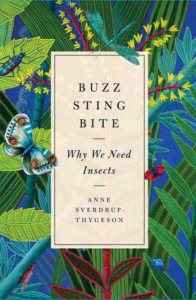 The weather appears to have finally (finally!) turned here in Cleveland. Soon, we will be seeing more flowers blooming and leaves growing on trees, and enjoying warm breezes passing through our windows. But as you go for your walks or get going on your spring cleaning around the house, spare a thought for the six-legged insects that buzz and bumble their way past you. Turns out, they’re doing important work.
The weather appears to have finally (finally!) turned here in Cleveland. Soon, we will be seeing more flowers blooming and leaves growing on trees, and enjoying warm breezes passing through our windows. But as you go for your walks or get going on your spring cleaning around the house, spare a thought for the six-legged insects that buzz and bumble their way past you. Turns out, they’re doing important work.
What kind of work, you ask? Just ask Anne Sverdrup-Thygeson, a professor from the Norwegian University of Life Sciences. Buzz, Sting, Bite: Why we need Insects is her breezy, enthusiastic study of the lives of insects and their importance to our environment. Across nine chapters Sverdrup-Thygeson offers up countless delightful and weird anecdotes about why insects are essential to our way of life.
Take our food, for example. Without insects many of the foods we enjoy would either taste significantly worse without insects pollinating them, or just would not exist at all. Chocolate is made thanks in large part to the efforts of the chocolate midge, an insect smaller than the head of a pin, which pollinates cacao flowers in the world’s rain forests. It is a long and fraught process, only 3 of 1000 cacao plants get pollinated, but without them those chocolates you’ve been munching on while we’ve been kept indoors would not exist. Or, for a more speculative story, have you ever wondered what the biblical miracle food Manna is? It is a question with no definitive answer, but the most well-supported hypothesis out there is that the miracle food is actually crystallized honeydew secreted from the Tamarisk manna scale, an insect which feeds on sap from plants which only grow in the Middle East.
Stories like this fill this book and are what make it so engaging. From stories about the dating and parenting lives of insects (e.g. be glad your partner didn’t eat you after the kids were born), to how insects and plants have a never-ending symbiotic relationship with each other (e.g. oregano goes through a lot of stress to end up on your pizza), Buzz, Sting, Bite shows us how some of the planets smallest creatures have some of the largest impact on our ecology. And that’s not all. One of the final chapters details how much we can learn from insects, and how they might help us reverse some of the damage we’ve done to the climate. One species of beetle apparently loves to eat plastic, and it’s poo is OK to use as manure for plants. Another beetle, if you starve it, ages backwards. Imagine what we could learn from these little creatures. If you’re interested in reading some pop science., this book will fit the bill.
Buzz, Sting, Bite is available at the Lee Road Branch of Heights Libraries and electronically on Overdrive.


